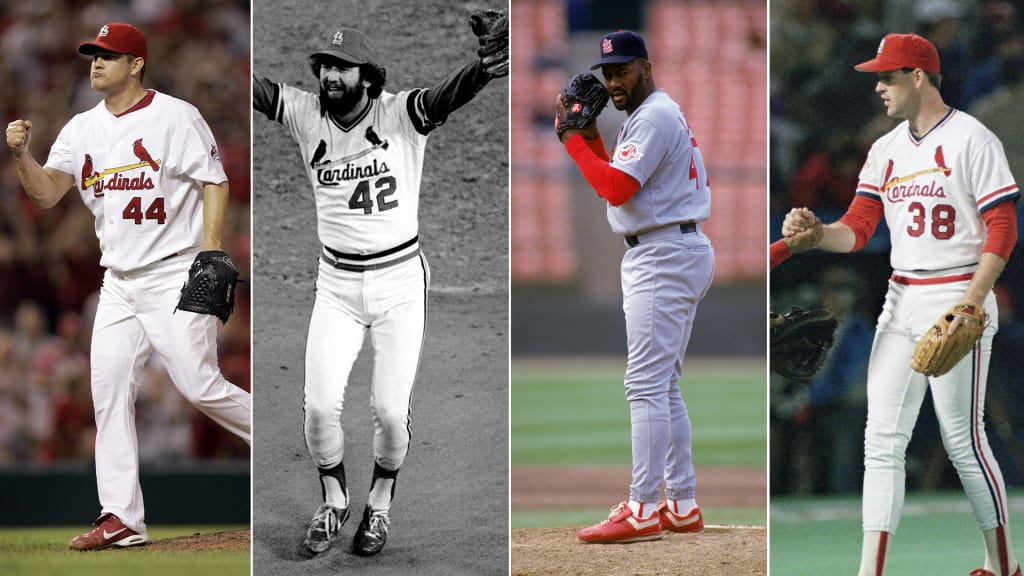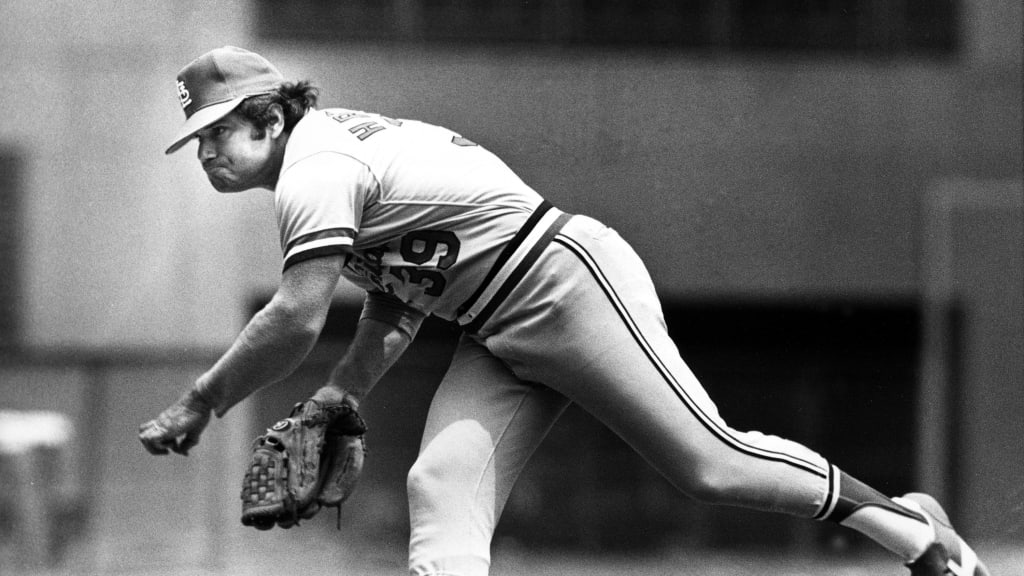
No one loves a good debate quite like baseball fans, and with that in mind, we asked each of our beat reporters to rank the top five players by position in the history of their franchise, based on their career while playing for that club. These rankings are for fun and debate purposes only … if you don’t agree with the order, participate in the Twitter poll to vote for your favorite at this position.
Here is Anne Rogers’ ranking of the top 5 relief pitchers in Cardinals history.
1. Jason Isringhausen, 2002-08
Key fact: Holds the Cardinals’ all-time saves record with 217
When Isringhausen was a free agent at the end of 2001, he got a call from Bill DeWitt Jr. The Cardinals’ owner wanted to see what it would take to get Isringhausen to sign with St. Louis.
“Little did he know I would have paid him to come here and pitch,” Isringhausen said last year, when he was inducted into the Cardinals Hall of Fame.
It didn’t matter that the Rangers had offered more money; the Brighton, Ill., native wanted to pitch for his hometown team, and he wanted to win. The Cardinals signed their new closer to a four-year, $27 million deal in December 2001 -- the club’s most lucrative free-agent reliever deal until Brett Cecil in 2016.
"When we started talking with Jason, he made it clear that while there was a certain question of compensation that was important to him, beyond that, it was dependent on a lot of other factors,” DeWitt said after the signing.
The deal was worth it. The right-hander came to St. Louis to win, and he helped the club do a lot of that over his seven seasons. Of his 300 career saves, 217 came with the Cards. He posted a 2.98 ERA with the club, with a postseason ERA of 2.36 in 26 2/3 innings, including eight saves. He went to the 2004 World Series the same year he saved a league-leading 47 games. He was an All-Star in 2005. And though he missed the 2006 World Series victory due to injury -- postseason closing duties were handed to rookie Adam Wainwright -- Isringhausen came back as strong as ever in 2007, with a 2.48 ERA.
Isringhausen ranks third among Cardinals relief pitchers with 373 strikeouts, and his 401 relief appearances are the sixth most in club history.
2. Bruce Sutter, 1981-84
Key fact: Led the National League in saves in three of his four seasons with the Cardinals
The pitch Sutter threw to win the 1982 World Series and make him a Cardinals icon was not the pitch that made him famous. With nobody on base and only one out between the Cardinals and the championship, Sutter concluded a 10-pitch at-bat with a fastball to the Brewers’ Gorman Thomas. It gave St. Louis its first World Series title since 1967 and started a run of success for the club in the ‘80s.
Sutter came to the Cardinals as part of Whitey Herzog’s roster restructuring in 1980. The closer was a year removed from winning the 1979 NL Cy Young award for the Cubs, with 37 saves and 110 strikeouts in 101 1/3 innings. In three of his four seasons with the Cardinals, Sutter finished in the top 10 in NL Most Valuable Player Award voting and top five in Cy Young Award voting. He left with the franchise record for saves (127, since surpassed), as the first NL closer to reach 200 saves and as the league’s all-time saves leader.
It all came from his split-finger fastball, the pitch he learned as his career was dwindling in the Cubs’ Minor League system. Sutter popularized the pitch, and it helped him become the most dominant closer in the league. He was elected to the National Baseball Hall of Fame in 2006. Despite spending more time with other teams in his career, he went in as a Cardinal.
“He had the best makeup of any closer I’ve ever seen,” Herzog says on Sutter’s Hall of Fame page. “He just cut the percentages down for me from 27 outs a game to 21.”
3. Lee Smith, 1990-93
Key fact: Only Cardinal to post three consecutive 40-save seasons
For more than a decade before Isringhausen eclipsed the Cardinals’ saves record, it belonged to one of the best closers of all time. Of Smith’s 478 career saves -- No. 3 on the all-time list -- 160 came in parts of four seasons with the Cardinals.
Smith went into the Hall of Fame as a Cub after spending the first eight years of his career on the north side of Chicago, but some of his finest years on the mound came with his brief time in St. Louis. Needing a closer to replace Todd Worrell, who was sidelined because of elbow surgery, the Cardinals acquired Smith, then 32 years old, from the Red Sox for outfielder Tom Brunansky on May 4, 1990. Smith took over closing duties for the Cards and had a 2.10 ERA across 68 2/3 innings. He was just getting started.
In 1991, he led the Majors with 47 saves and the NL with 61 games finished. In ’92, he led the league with 43 saves. He posted 43 more in ’93 before being traded to the Yankees during the last month of the season. Smith appeared in 245 games as a Cardinal and was called on to finish 209 of them. He went to three of his seven All-Star Games with St. Louis, finishing second in Cy Young voting in ’91 and fourth in ’92.
4. Todd Worrell, 1985-89, ‘92
Key fact: Began his career with three consecutive seasons of 30-plus saves
Worrell made his debut on Aug. 28, 1985, in the middle of a heated division race with the Mets. As an injury replacement for Jeff Lahti, Worrell picked up five saves down the stretch and helped the Cardinals clinch the division. He allowed one run in 6 1/3 innings against the Dodgers in the NL Championship Series and notched the save in Game 1 of the World Series against the Royals. He was also the pitcher who beat out Jorge Orta to first base in Game 6, only to have umpire Don Denkinger call Orta safe. Despite losing the ’85 World Series, Worrell’s stellar Cards tenure had just begun.
The right-hander won the NL Rookie of the Year Award in 1986 with a league-leading 36 saves and 60 games finished as well as a 2.08 ERA over 103 2/3 innings. His 129 saves in six years with St. Louis rank third in franchise history, and he might have had more if not for injuries that sidelined him for two years. By the time he returned in ’92, the Cardinals had Smith as their closer.
5. Al Hrabosky, 1970-77
Key fact: Finished in the top five of Cy Young voting in 1974 and ‘75
Hrabosky knew his time in the Majors would be finished if he didn’t learn how to control himself on the mound. His mind wandered, and he could not channel his adrenaline. But on June 11, 1974, Hrabosky entered the ninth inning with a 1-0 lead, two runners on and two outs. He paused on the mound, talked himself into a frenzy, stormed up the mound and fired three pitches -- all strikes. The “Mad Hungarian” was born.
Over 41 innings from July 14 to Sept. 17 that season, Hrabosky allowed one run and finished the year fifth in Cy Young Award voting. He grew his famous mustache to add to his persona, and he spent the next three seasons as the Cardinals’ closer. In 1975, he led the NL with 22 saves and a 13-3 record (.813 winning percentage), compiling a 1.66 ERA to finish third in Cy Young voting. He also finished eighth in MVP voting.

Honorable mentions
Trevor Rosenthal had back-to-back seasons of 45 and 48 saves before encountering arm trouble. In 2015, he was elected to the All-Star Game and finished the season with a 2.10 ERA over 68 2/3 innings.
Lindy McDaniel alternated between the rotation and bullpen from 1956-62, tallying 66 wins and 66 saves with four double-figure win years.
Dennis Eckersley is a Hall of Famer because of what he did with the A’s, but he compiled 66 saves for the Cardinals at 41 and 42 years old.
Ted Wilks was 51-20 with a 3.25 ERA for the Cardinals and notched the World Series-clinching save in Game 6 of the 1944 World Series against the St. Louis Browns.
Joe Hoerner was a crucial part of the NL pennant-winning teams in 1967 and ’68, including a 1.47 ERA as the closer in ’68.
